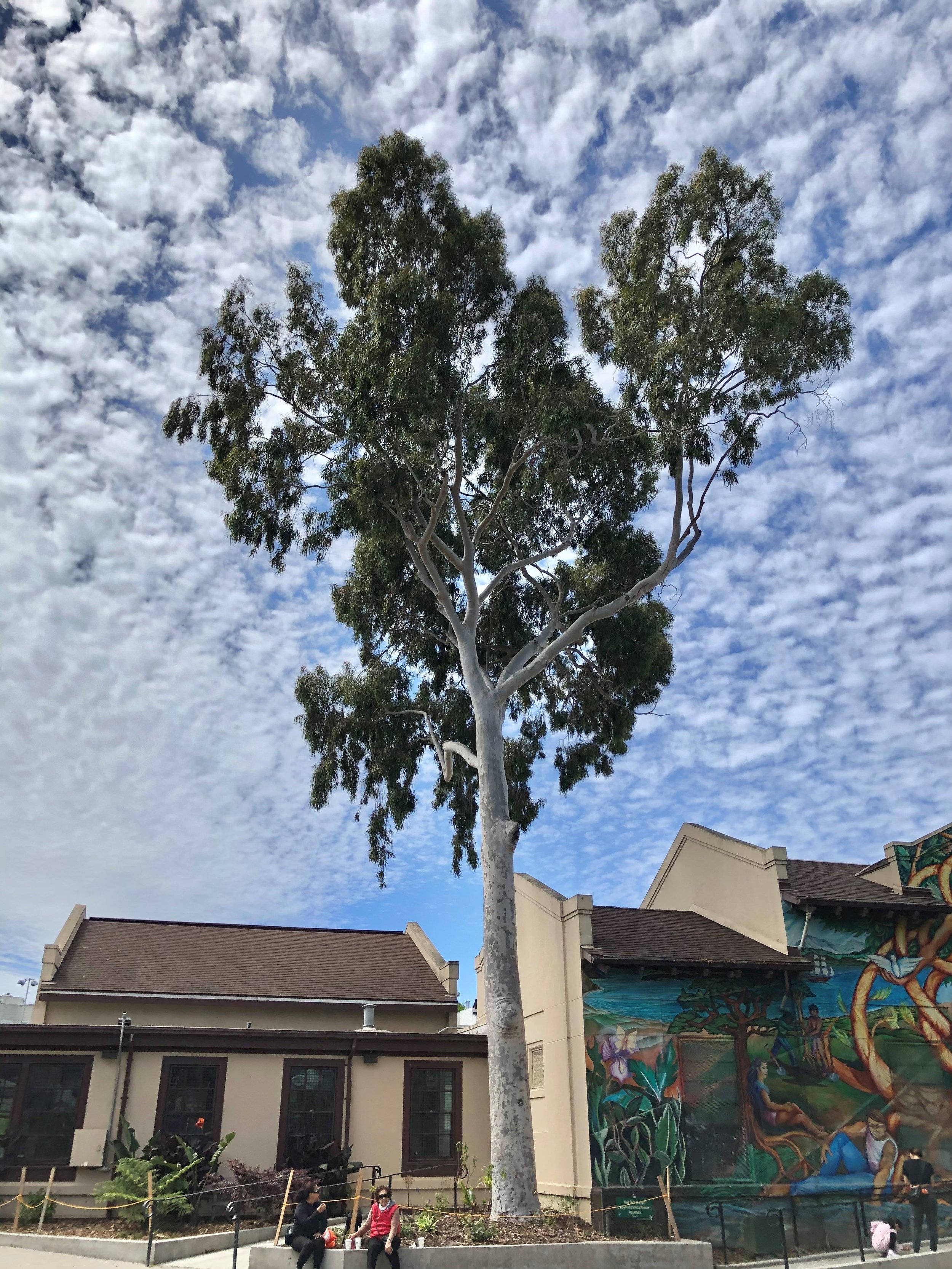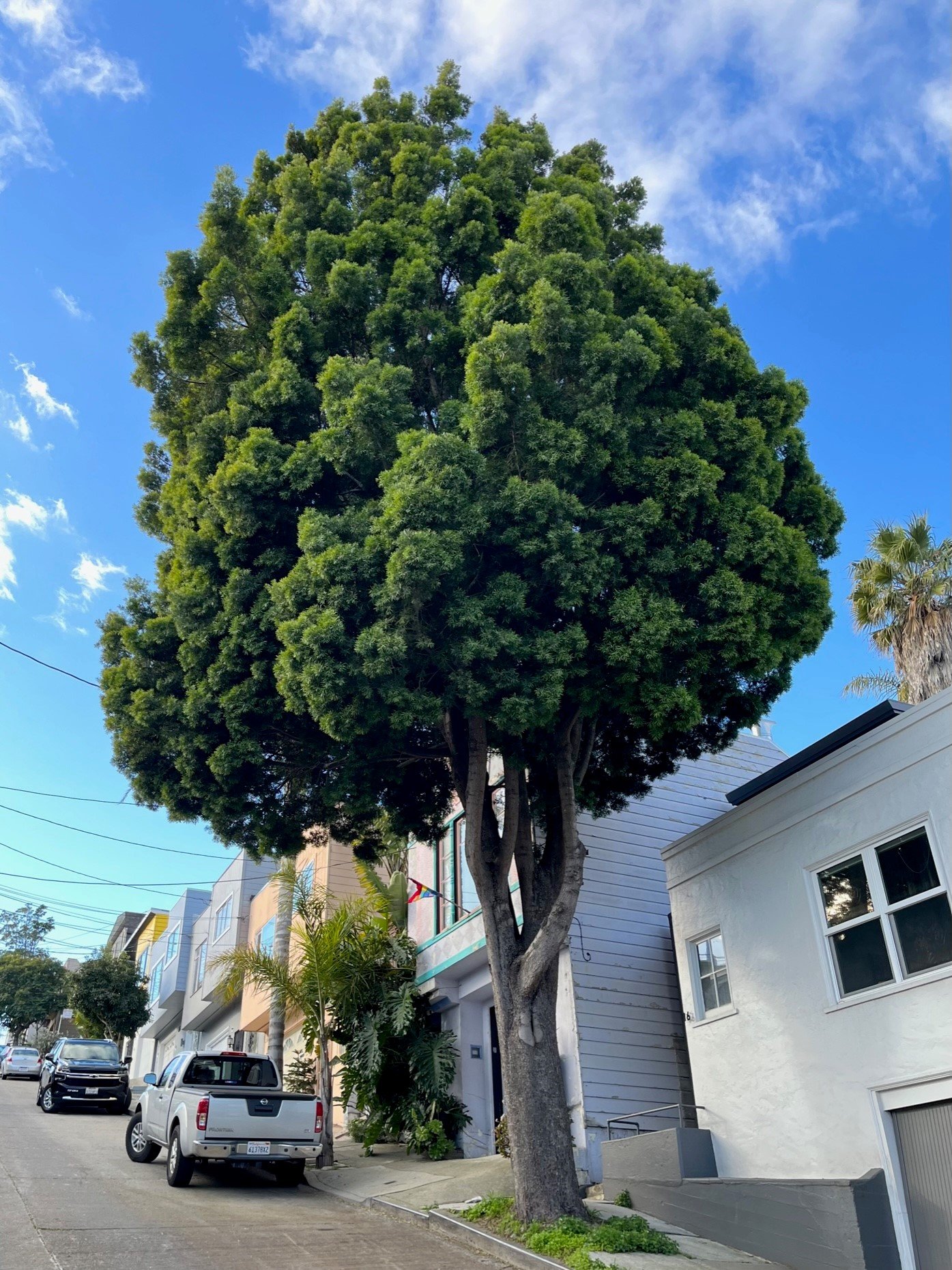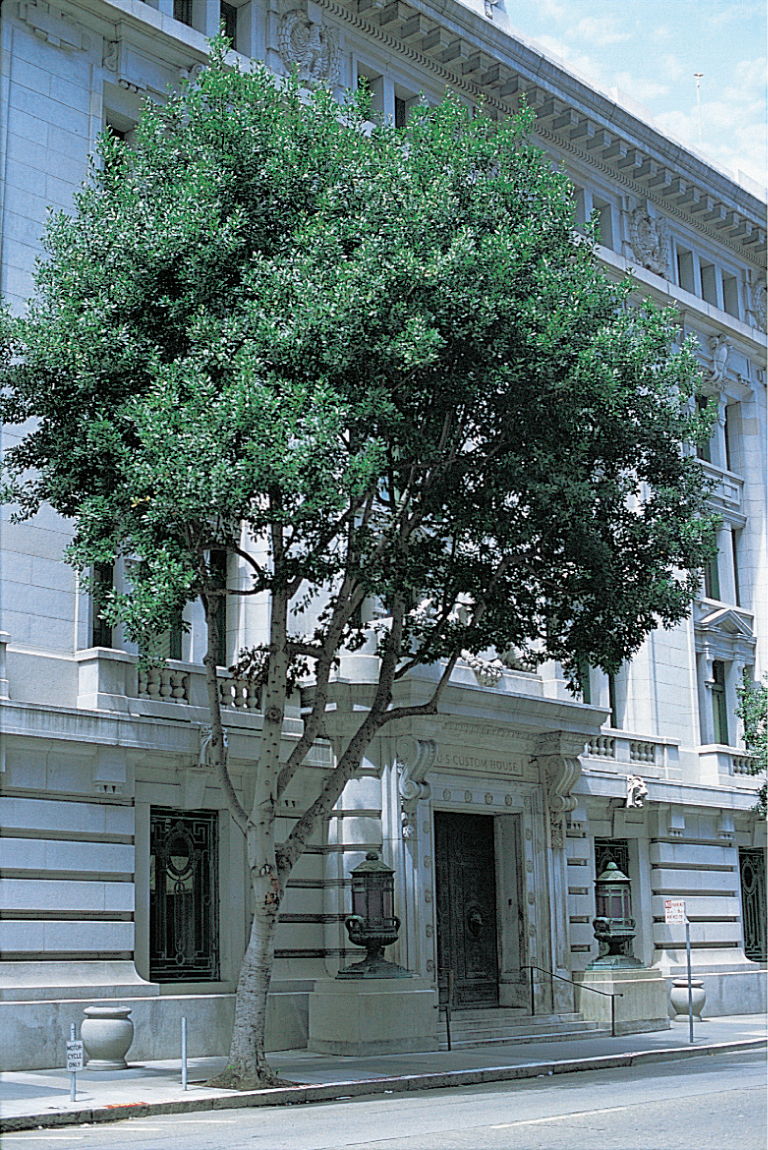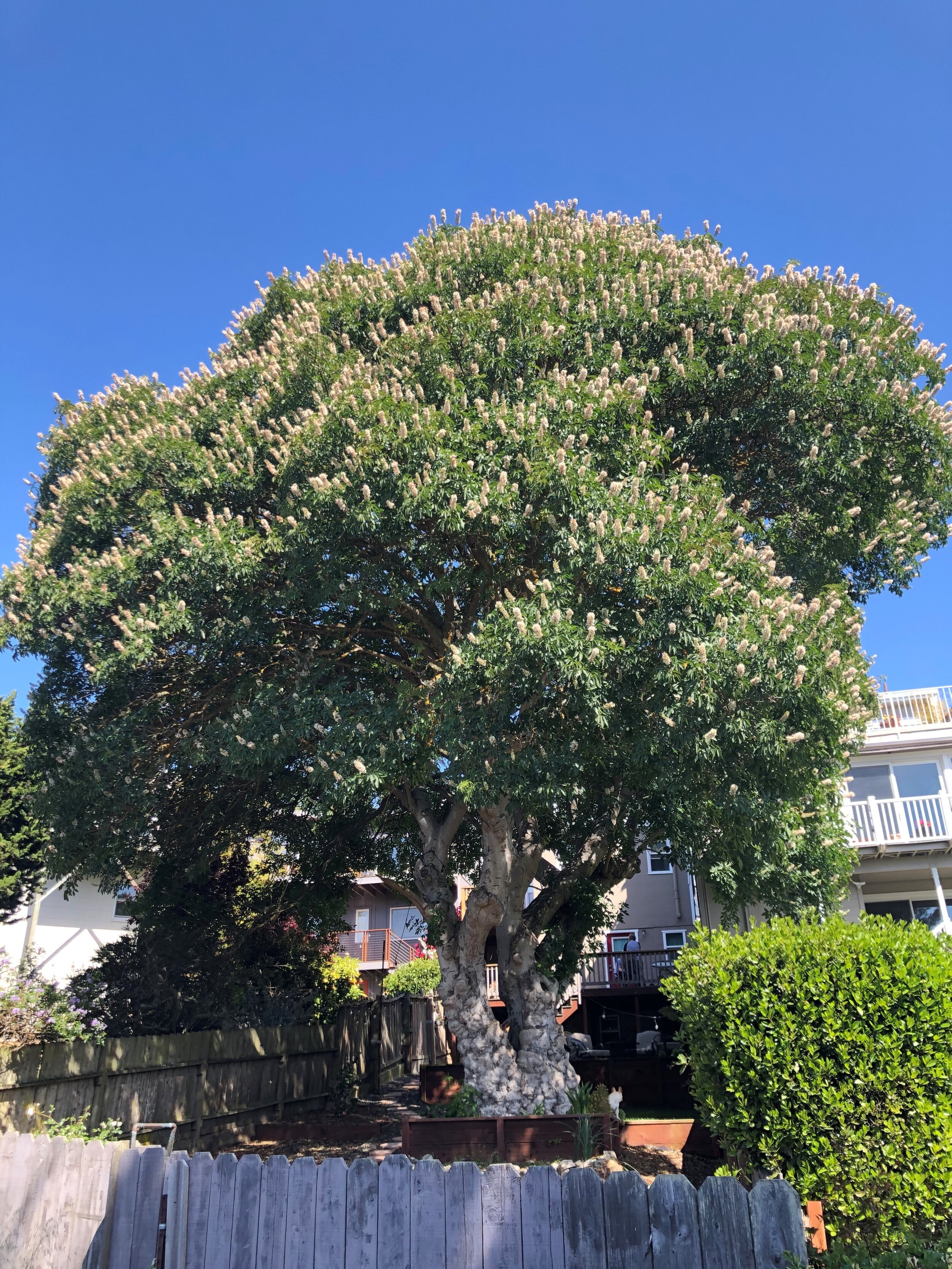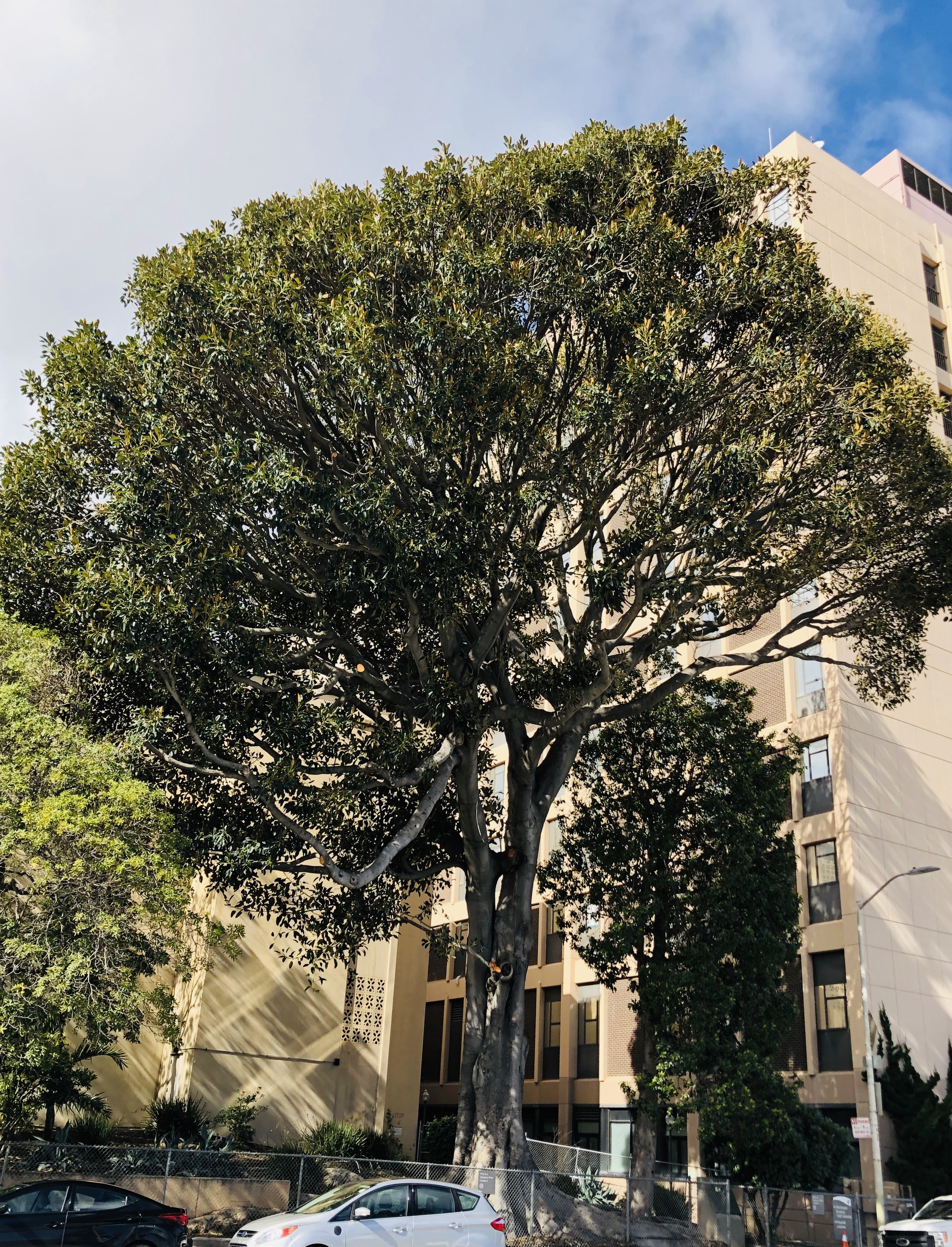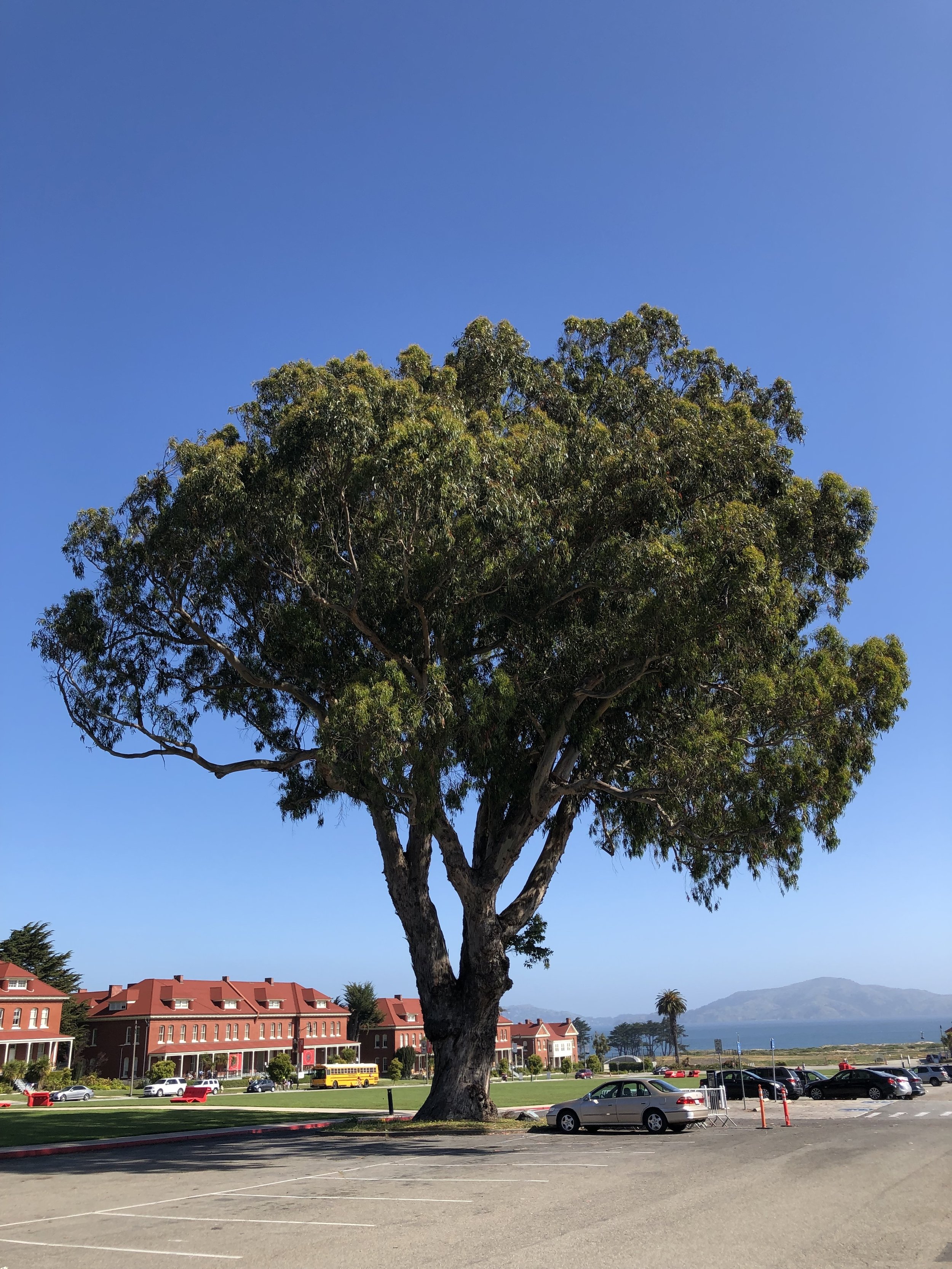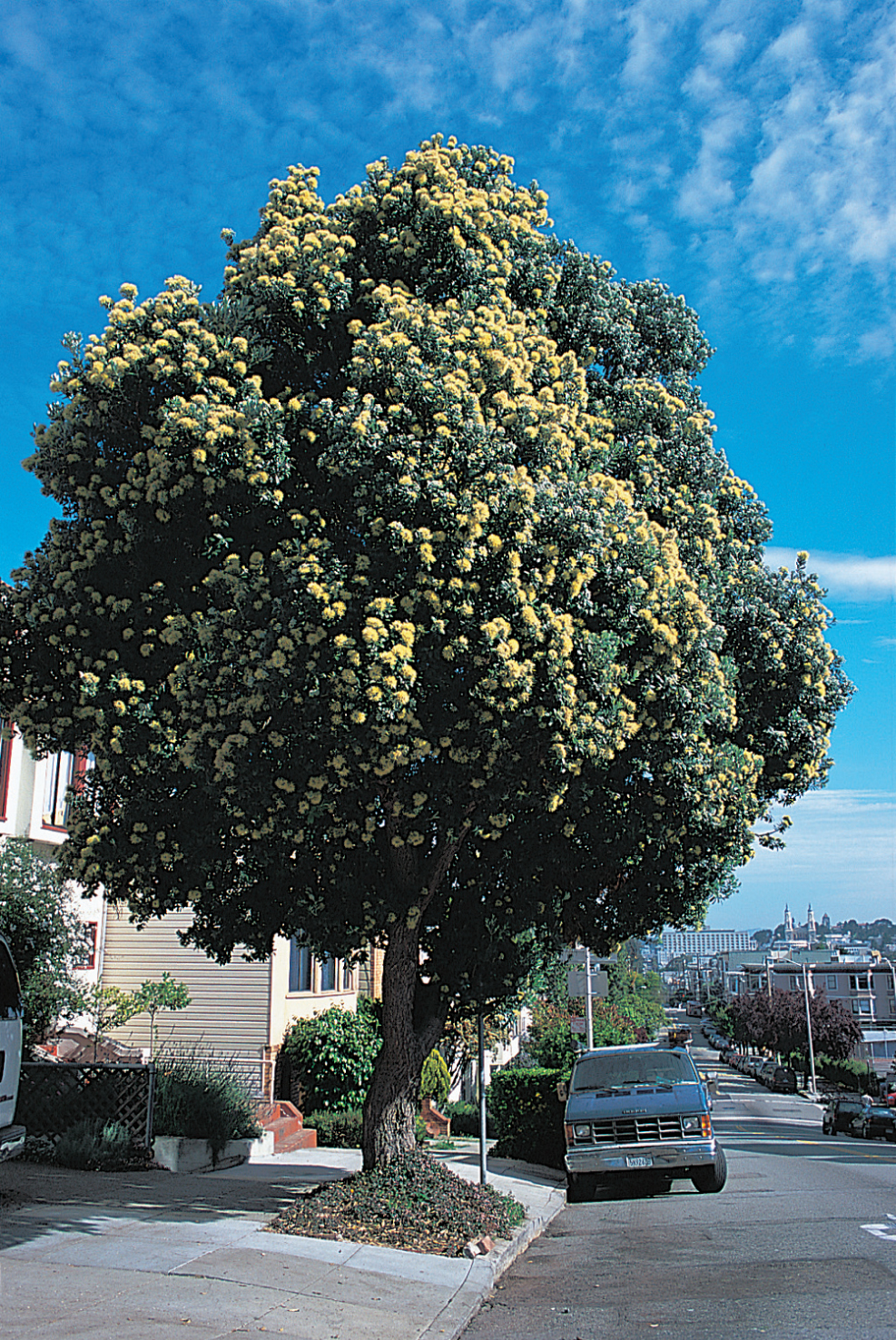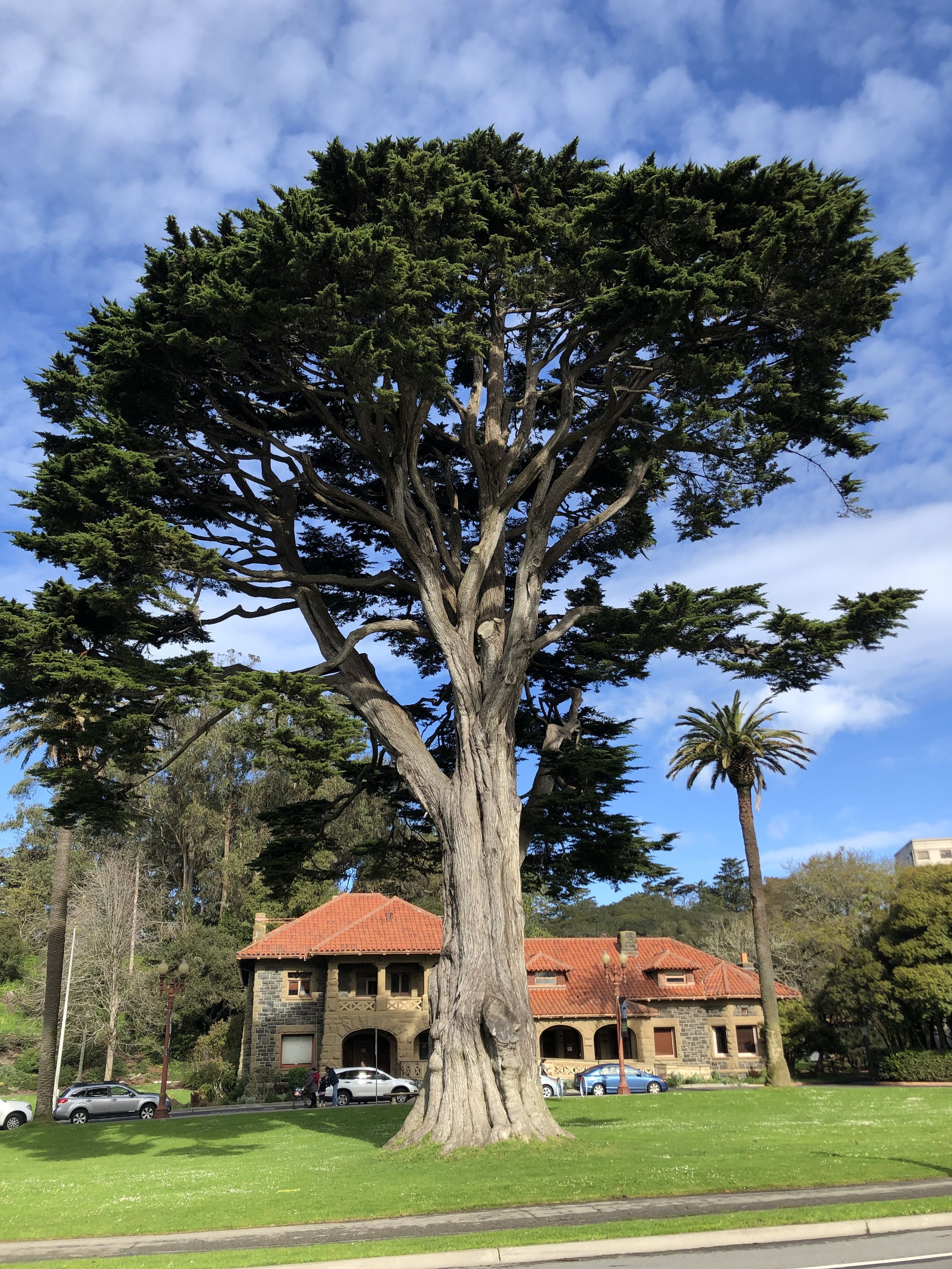SAN FRANCISCO’S TOP 10 (ISH) “LANDMARK TREES”
This is my own personal, 100% subjective list of San Francisco’s top landmark trees. How do you know when a tree is a “landmark tree”? I’ll admit that I use the standard that Justice Potter Stewart famously used to identify hard-core pornography in a 1964 Supreme Court case: he said “I know it when I see it”. Being big helps, of course; the the visual impact that the tree makes is important. Rarity is a plus - there are some trees that wouldn’t make my list but for the fact that they’re so rare in San Francisco. And it helps to have a good story associated with the tree - something historical that connects the tree to its neighborhood or the fabric of the City. With those ground rules, here are my top “landmark trees” for San Francisco. Originally I made this a “top 10” list, but I keep finding amazing trees that just needed recognition, so the list keeps growing (when I find new amazing trees) and shrinking (when they did or are removed - see the bottom of this page for an “emeritus” list of trees that are no longer with us). It’s now a “top 12” list! To create some drama, the list is in reverse order - but if you really can’t wait, skip to the end to see the #1 best tree in San Francisco. And if you want to stay in touch with me on San Francisco tree stuff, I use Instagram for that - find me there @sftreeguy.
#12 SPOTTED GUM TREE - 19TH STREET IN THE MISSION I first encountered this spectacular tree on our Inner Mission tree tour in May 2020. I drove by again in December 2022 and decided that it need to be elevated to the “top” list (now the top 13).
The tree is a spotted gum (Corymbia maculata) from Eastern Australia. I used to think of spotted gums as better suited to southern California, but I’m seeing more and more successful examples around San Francisco. This one just couldn’t be better - tall, with perfect form, beautiful mottled bark characteristic of the species, and nicely situated adjacent to Mission Community Pool on 19th Street between Guerrero and Valencia Streets.
Spotted gums were also planted the entire length of Van Ness Avenue, in the center median as part of the bus rapid transit project that (finally!) launched earlier in 2022. And there are some beautiful examples of the tree surrounding the Transamerica pyramid, interspersed among red flower gums (another Corymbia - Corymbia ficifolia).
#11 - AFRICAN FERN PINE - 16 BRONTE IN BERNAL HEIGHTS This African fern pine (Afrocarpus gracilior) is the biggest (by far) of its species in San Francisco. I think it’s the best tree in the Bernal Heights neighborhood, and that’s saying something, because Bernal Heights has a lot of trees, and a lot of great trees. It’s massive, in the bloom of health, and has a wonderful form. But it might be the least known tree on this list, because unless you have a reason to visit Bronte Street, you’re probably not going to swing by this spectacular tree. Every time I visit this tree, as I make the turn on Cortland I hold my breath to make sure it’s still there - I do worry that homeowners sometimes are the enemies of landmark trees.
Fern pine is one of the few San Francisco street trees from Africa - the tree isnative to Ethiopia, Kenya, Tanzania, and Uganda.
#10 COAST CORAL TREE - 422 WALLER STREET IN THE LOWER HAIGHT I’ve known about this tree for a long time, but it wasn’t until Richard Turner, Jason Dewees and I visited it during our Lower Haight #covidtreetour that I realized how large and impressive it had become. Coast coral trees (Erythrina caffra) are very very rare as street trees in San Francisco - there are at most a handful in the entire city - and this is by far the largest. The tree has beautiful red flowers (the scientific name derives from the Greek word word for red, erythros), but strangely, I’ve never seen this tree bloom. Coast coral trees are native to southeastern Africa, but they’re a popular introduced tree in Southern California. In fact, coral trees are the official tree of Los Angeles. Perhaps one of the silver linings of climate change will be that we’ll see more coral trees in San Francisco?
#9 BRAZILIAN PEPPER TREE - 3RD STREET AND YOSEMITE IN THE BAYVIEW This tree is in the triangle median where 3rd and Yosemite intersect. I don’t think anyone knows much about the history of this tree, but it’s a giant of its species and has been officially landmarked by the City of San Francisco. Brazilian pepper trees (Schinus terebinthifolius) are native to southern Brazil, Paraguay and northern Argentina. The tree has become an invasive pest in many subtropical areas; in southern Florida, it covers some 700,000 acres, and the tree cannot be legally sold or imported in Florida or Texas. The tree is in the Anacardiaceae family, the family that also brings us poison ivy and poison oak. Like their to-be-avoided relatives, Brazilian peppers have sap that can cause skin reactions in very sensitive people (though most of you will be OK).
Brazilian Pepper Tree (Schinus terebinthifolius)
Sweet bay (Laurus nobilis)
#8 SWEET BAY - 555 BATTERY STREET IN THE FINANCIAL DISTRICT This is the classic bay laurel of antiquity, the symbol of victory and honor. We call it sweet bay, Italian bay or Grecian laurel - but botanists call it only one thing - Laurus nobilis. The Greek word for laurel is dhafni, after the nymph Daphne in Greek mythology. According to the myth, the gods helped Daphne escape Apollo’s attempted rape by turning her into a laurel tree. Apollo made the tree sacred, and it became a symbol of honor. The Greeks also began the tradition of crowning victors and distinguished persons with a wreath of laurel, from which we get the term laureate. This is also the traditional bay leaf used in cooking - not to be confused with our California bay (Umbellularia californica), which is native to the Bay Area but is much stronger as an herb. A native of the Mediterranean region, sweet bay thrives as a San Francisco street tree, embracing our own Mediterranean conditions (dry summers, wind, fog, sandy soil). The tree at 555 Battery is San Francisco’s largest sweet bay, and it has a special location in front of the Beaux Arts U.S. Customs House. It has also been given official landmark status by the City of San Francisco.
Penny Lane’s California buckeye (Aesculus californica)
#7 CALIFORNIA BUCKEYE ON POPPY LANE Poppy Lane is one of Glen Park’s unpaved “country roads”. It extends east and west of Diamond Street - to the east, it dead ends just before reaching Bemis Street. To the west, Poppy connects to Conrad Street, and that is where you’ll find this majestic California buckeye tree (Aesculus californica). I only learned about this tree in October 2020, when we were chalking our Glen Park socially distanced #covidtreetour.
The buckeye tree at McAllister and Willard Street North has more history, so I’m giving it a higher ranking, but this tree is bigger - in fact, I think it is the largest California buckeye in San Francisco.
To find the tree, park on Diamond Street at the intersection of Poppy Lane, and walk up the cobblestone-paved lane. You will see the tree on the right - even though it’s in a backyard behind a fence, you can’t miss it!
If you’re curious, two other nearby Glen Park country lanes are Penny Lane and Ohlone Way. Easy to find with your smartphone - they’re fun to explore.
#6 NORTHERN RATA AND TITOKI - DOUBLE NEW ZEALAND ON VALLEJO STREET Neither one of these trees would make this list on their own, but together they’re a “don’t miss” for tree lovers. Near the iron-gated Italianate Victorian home at 1772 Vallejo Street, you’ll find two very rare trees from New Zealand. To the left of the driveway at this address is a northern rata (Metrosideros robusta), a close relative of the much more common New Zealand Christmas tree (Metrosideros excelsa). In the yard to the right is one of my favorite trees in all of San Francisco—a gorgeous and extremely rare titoki tree (Alectryon excelsus). Anyone walking past without much tree knowledge would just see a couple of green blurs, but these two make my list because of their size, rarity, and their origin (how did two such unusual New Zealand trees end up here??). The northern rata (the tree in the photo on the right) was nominated in 2018 to be an official City of San Francisco landmark tree. I happen to be on City’s Urban Forestry Council, which does the landmarking, and I voted “yes”, but the Council voted 3-2 vote not to landmark the tree. So it’s not official - but it makes my personal list, at #8.
Northern rata (Metrosideros robusta)
Mary Ellen Pleasant historical marker
#5 SIX BLUE GUM EUCALYPTUS TREES -1661 OCTAVIA STREET Mary Ellen Pleasant, an African American woman often called California’s “Mother of Civil Rights,” planted the row of six giant blue gums (Eucalyptus globulus) at 1661 Octavia Street, between Bush and Sutter Streets, in Pacific Heights. Though born a slave in 1817, she came to own a sprawling 30-room estate at this address, which has been called the western terminus of the Underground Railway that ushered fugitive slaves to freedom in pre–Civil War times. Once freed herself, Pleasant spent many of her early years helping fugitive slaves escape the American South. Pursued by the law, she headed to gold rush San Francisco in 1852, where with her business acumen she parlayed an inheritance from her first husband into a small fortune. She used her wealth to continue supporting African American rights. In 1868, long before the civil rights battles of the next century, Pleasant brought a lawsuit against two San Francisco streetcar lines that had denied her the right to ride because of her race. Her suit ultimately went to the California Supreme
Court, where she won the right for all African Americans to ride the streetcars. Later in life, Pleasant suffered tabloid-driven scandals and financial reverses. She died in San Francisco in 1904 and is buried in Tulocay Cemetery, north of the city, in the town of Napa. All that is left of her opulent mansion is the row of six giant blue gum eucalyptus she planted in front of her property on Octavia Street. There are larger blue gums in the city, but not many - and these trees get extra credit for their historical significance. Set in the sidewalk amid these trees, a historical marker identifies these trees as something special—a part of San Francisco’s history.
#4 MORETON BAY FIG ON VALENCIA STREET, NEAR CESAR CHAVEZ The address of this tree is technically 3555 Cesar Chavez Street, but the location is around the corner on Valencia Street. It’s a giant Moreton Bay Fig (Ficus macrophylla). This tree was planted during the time of Hubert Howe Bancroft, who amassed the famous Bancroft Library of books on the history of California that was located here from 1881 until 1906, when the library was purchased by the University of California and removed the following year to its Berkeley campus. There’s a historical marker about the library near the tree, to the right as you face it. Moreton Bay fig is a rare tree in San Francisco (it’s much more common in southern California), and it’s by far the largest specimen of the species in the City. The tree is getting on in years, and has recently lost some big limbs, but it’s still a mammoth tree. On March 24, 2008, then-Mayor Gavin Newsom added this tree to the City’s official landmark tree list.
Moreton Bay fig (Ficus macrophyla)
“Centennial Tree” - blue gum eucalyptus (Eucalyptus globulus)
#3 “CENTENNIAL” TREE - BLUE GUM EUCALYPTUS ON PRESIDIO MAIN POST This isn’t the most spectacular eucalyptus tree in San Francisco, but it gets bonus points for its historical significance. This tree was planted on July 4, 1876 by Angelo Beretta to mark the 100th anniversary of the Declaration of Independence. (Berreta was the first “post trader” in the Presidio - post traders were merchants who sold the “extras” to soldiers - tobacco, beer, civilian clothing and the like.) Beretta planted three eucalyptus trees in honor of his three daughters, but two of the trees were lost when the Army cleared the area for the parade ground. The tree was planted in the middle of what was then the Sixth Army parade ground (it’s now in the middle of the Presidio’s Main Post, surrounded by Army buildings that have been renovated into museums, schools, hotels and restaurants. A plaque at the base of the tree commemorates its planting at the nation’s centennial - it was a gift in 1976 by Beretta’s descendants, who still live in the Bay Area. There are other great trees within eyesight of the Centennial Tree - some of the city’s best cabbage palms (Dracaena) are in the lawn to the south of this tree, and the New Zealand Christmas trees that I photographed for my Trees of San Francisco book are a stone’s throw away.
New Zealand Christmas tree (Metrosideros excelsus)
#2 NEW ZEALAND CHRISTMAS TREE AT STANYAN/17TH The large, mature tree at 1221 Stanyan Street, near 17th, is a New Zealand Christmas tree (Metrosideros excelsus) - one of San Francisco’s most common trees, popular for its showy red bottlebrush flowers. And indeed all of the many hundreds of New Zealand Christmas trees on the City’s streets have red flowers - except for this one. Every June, this tree pops with spectacular yellow flowers. The backstory here involves some interesting history that helps elevate the tree to its near-the-top ranking on this list. The story goes back to Victor Reiter, San Francisco’s most famous plantsman from the 1940s until his death in 1986. In 1940, there was a natural mutation of the species on tiny Motiti Island in New Zealand’s Bay of Plenty. Reiter was one of the first Californians to obtain a cutting of the yellow-flowering mutant. The Reiter family lived in several homes in a three-block stretch of Stanyan Street, and they planted the curiosity in front of their 1221 Stanyan address - still occupied today by a family member. And 75 years later, the tree is still thriving, a giant specimen that has been lovingly cared for by the owner, and which recently received landmark tree status by the City. It’s a beautiful mutant with an great history and pedigree. It also happens to be my personal favorite tree in the City, which may have something to do with its ranking of #3 on this list.
Monterey cypress tree (Hesperocyparis macrocarpa)
#1 MONTEREY CYPRESS AT MCLAREN LODGE This tree really had to be #1. Arguably the best known tree in San Francisco, the massive Monterey cypress tree (Hesperocyparis macrocarpa) stands in front of McLaren Lodge, the headquarters of the City’s Recreation and Park Department. It was planted around 1880, when Golden Gate Park was run by William Hammond Hall, who started the effort to plant thousands of trees to create a park out of what had been sand dunes. Each year during the holidays, the tree is lit with Christmas lights, a tradition that dates back to William Hammond Hall’s sucessor, John McLaren, a brilliant botanist who took over the park in 1887, and continued experimenting to find trees that would succeed in the park’s challenging climate and sandy soil. In 1929, McLaren had the tree lit for the holidays to cheer up City residents then enduring the Great Depression. On his death bed, McLaren supposedly requested that the tree lighting tradition be continued. His wish was granted, and 90 years later the tree has become the official holiday tree of San Francisco. It’s not surprising that a Monterey cypress would thrive on former sand dunes - the tree is native to similar conditions in coastal Central California However, only two native stands of Monterey cypress exist. One is at Point Lobos State Natural Reserve (3 miles south of Carmel), and the other is in Pebble Beach. This limited natural range is the smallest of any tree in California. Size, history and location, location, location - I vote for this one as San Francisco’s #1 landmark tree.
And now for some trees that were in the top 10, but sadly have died or been cut down.
BUNYA BUNYA -201 VICENTE IN WEST PORTAL [FORMERLY #4; CUT DOWN BY OWNER FEBRUARY2024] Bunya-bunya trees (Araucaria bidwillii) have a distinctive silhouette - the tree’s branches are spaced evenly along the trunk, giving the tree a symmetrical look. Bunya bunyas are closely related to Norfolk Island pines, monkey puzzle trees, and other southern hemisphere members of the ancient Araucaria genus, all of which share a certain reptilian symmetrical look. The tree is native to the Bunya mountains of Queensland in northeastern Australia. Perhaps the most unusual feature of the bunya-bunya is its football-sized female cone, which looks something like a pineapple and can weigh 10–15 pounds (the record is held by a 17-pounder). The cones, which set every three years, are produced high in the tree’s canopy and can cause serious injury when they fall. An entire grove of bunya-bunyas was removed from a park in Fisherman’s Wharf after a 16-pound cone fell on a man, causing serious injury. You’re safe under this tree in West Portal - it must be a male specimen, as I’ve never know it to have the large female cones. So what boosts this tree to #4? It’s a large, spectacular example of a rare and interesting tree, and I’m giving it some extra credit for its location - how did this tree end up in a front yard in West Portal?
CALIFORNIA BUCKEYE TREE AT MCALLISTER/WILLARD STREET NORTH [FORMERLY #2; TREE DIED WINTER OF 2022-2023.] The California buckeye tree (Aesculus californica) is a San Francisco native, existing within the current city limits before the arrival of Europeans. It’s one of California’ most beautiful native trees, growing to 30 feet or more in the state’s coastal range and Sierra foothills. The tree produces showy, long-lasting clusters of white flowers in May and June. By far the largest California Buckeye in the City is at 2694 McAllister Street, near the University of San Francisco. The tree was scheduled for removal in 1999 in connection with new construction on the lot, but after a neighborhood outcry, the property owner changed the plans to build around, and so preserve, the tree. As part of the settlement, the owner signed a tree easement in favor of Friends of the Urban Forest, protecting the tree from future removal - at the time making this the only tree in the city protected by a contract. The City’s Urban Forestry Council recently voted to add this tree to our official landmark tree list - I’m not sure what took us so long!
